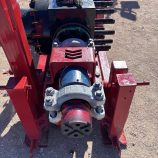Manufacturing Analytics

Posted: February 20, 2024
At a time when data is synonymous with currency, the oil and gas industry stands on the brink of a technological renaissance. The advent of advanced manufacturing analytics is propelling the sector into a new age of efficiency and innovation. The international market for oil and gas analytics is set to top $52.46 billion by 2032, reflecting a compound annual growth rate (CAGR) of 22.45% from its $6.92 billion value in 2023.
Once characterized by its reliance on manual processes and experimental decision-making, the oil and gas industry now embraces the power of data to drive calculated decisions, streamline operations, and pave the way toward a safer and more sustainable future.
Here, we’ll explore the multifaceted benefits of data analytics, its strategic advantages, and emerging trends that promise to further revolutionize the industry.
Understanding Data Analytics in the Manufacturing Sector of the Oil and Gas Industry
Manufacturing analytics in the oil and gas industry involves various data analysis methods and statistical tools to process and interpret vast amounts of data generated during production processes. The goal is to gather and shape actionable insights that can lead to improved efficiency, increased safety, and reduced operational costs.

The process involves collecting, organizing, and analyzing huge amounts of information to identify patterns, trends, and insights, improving decision-making, performance, and profitability across the value chain.
Manufacturing analytics combines a range of digital technologies, including:
- Industrial Internet of Things (IoT) devices, which collect vast volumes of data
- Cloud computing networks that support and store colossal datasets
- Machine learning systems that analyze data
- 5G and edge networks to help share information in real time
Additionally, there's a growing trend in the sector towards implementing autonomous analytics. This enables systems to make decisions and execute tasks independently of human intervention.
Benefits of Utilizing Manufacturing Analytics in Oil and Gas Operations
The utilization of data analytics in oil and gas operations presents a multitude of benefits, leading to strategic advantages for companies.
Safety and Compliance
It goes without saying that safety is paramount in the oil and gas industry. Analytics can help monitor operational parameters to ensure they stay within safe limits and comply with regulatory standards. This might include monitoring for potential leaks and equipment malfunctions, predicting hazardous conditions, and ensuring that safety procedures are followed.
Lower Costs
Predictive maintenance and monitoring systems use sensor and IoT device data to identify irregularities in operations or machinery. Early warnings of malfunctions such as wear, component failure, blockages, leaks, or fatigue allow engineers to address issues promptly while they're still minor. This proactive approach reduces maintenance expenses by repairing components before failure, avoiding expensive replacements and lengthy downtime. Predictive maintenance helps extend equipment lifespan—and ultimately boost profits.
Increased Productivity and Efficiency
Data analytics can streamline operations by monitoring performance and identifying bottlenecks across the manufacturing floor. Sensors data allows for real-time monitoring and control of operations, so decision-makers can adjust processes swiftly and accurately.
The data-driven programming of CNC machine routes boosts manufacturing efficiency and precision. Algorithms swiftly evaluate design and material information to refine the machining sequence, reducing operation time and tooling wear—and enhancing the quality of the end product.
Using such detailed analytics in CNC machining allows for intricate paths beyond the reach of conventional programming, resulting in more efficient and adaptable manufacturing. This level of optimization leads to significant reductions in metal wasted on sub-standard components and energy consumption, as well as faster turnaround times for production cycles.
Better Decision-Making
Analysis of market trends, demand forecasts, and price fluctuations helps companies position themselves strategically in the market—and may even give rise to new innovative business models.
With real-time data and predictive insights, executives can make more informed decisions about investments, operations, and resource allocation. Understanding how assets perform over time also better informs choices about when to retire, replace, or refurbish equipment.
Manufacturing in the Oil and Gas Industry: How Analytics and Digitization Optimize Operations
The oil and gas industry, traditionally reliant on manual operations and empirical decision-making, has been undergoing a significant transformation with the shift to automated processes and the integration of digital data streams. Manual processes that were once time-consuming, prone to human error, and often hazardous are now faster, safer, and more accurate.
By harnessing big data analytics, machine learning, and AI, the industry can extract valuable insights that were previously inaccessible. This digitalization journey impacts various aspects of the industry, from collaboration and decision-making to operational agility.
Impacts on Collaboration and Operational Agility
Digital operations facilitate enhanced collaboration across teams and geographies. Cloud computing allows for the seamless sharing and updating of data, meaning that communication stays current and contiguous across the manufacturing floor regardless of physical location. The manufacturing plant becomes an integrated operations center where multidisciplinary teams work together to optimize production and respond to emerging challenges swiftly.
With automated data collection and analysis, businesses can respond to changes in market demand, regulatory environments, and operational conditions with greater speed and adaptiveness. Automated control systems can adjust to new inputs immediately, optimizing production in real time and adapting to changing circumstances without the lag of manual intervention.
Challenges and Considerations
Despite the clear benefits, the shift to digital operations is not without challenges. Cybersecurity becomes a critical concern as a more connected environment increases the potential for cyber-attacks; additionally, embracing digital transformation requires significant cultural shifts in the workplace.

Employees at all levels must adapt to new ways of working—and this can sometimes meet resistance. Upskilling workforces to handle new technologies and interpret complex data streams presents another hurdle. Moreover, there is a need to ensure that the transition does not create silos of digital expertise, but rather promotes an integrated approach where digital literacy is widespread.
To ensure a smooth transition to automated and digital processes, the oil and gas industry must invest in training and development programs. These programs can help build a digitally savvy workforce capable of operating new technologies and making the most of the vast amounts of data available. Change management practices are essential to help the workforce adapt to new roles and responsibilities in a digital work environment.
Future Trends: The Role of Data Analytics in Modernizing Oil and Gas Industry
Predictive and prescriptive manufacturing analytics will prove key to the oil and gas sector’s future. The industry is moving from descriptive analytics—which looks at what has happened—to predictive analytics, which anticipates what might happen. This shift is critical in forecasting demand, prices, and equipment failures.

Going one step further, prescriptive analytics not only predicts outcomes but also suggests actions to achieve desired results. This proves critical in complex decision-making scenarios such as capital investment or exploration strategies.
Integrated data ecosystems and data democratization mark another key trend, one which involves equipping a broader range of employees with the tools and skills needed to analyze and act on data-driven insights. The oil and gas industry is moving towards creating integrated data ecosystems that can break down silos and allow for seamless data sharing across departments and external partners. A holistic approach to data management enhances collaboration and enables more comprehensive analysis.
As the global focus on sustainability intensifies, data analytics will play a crucial role in the industry's energy transition efforts. These technologies can help companies reduce their carbon footprint, improve resource management, and develop renewable energy projects with greater efficiency.
Gilmore's Commitment to Digital Excellence
Manufacturing analytics in the oil and gas sectors leverage vast amounts of data generated from complex and high-stakes operations to not only optimize production but also revolutionize safety protocols and reshape supply chains.
Companies that effectively integrate digital data streams can better compete in a market that values speed, efficiency, and sustainability. They can operate with lower costs, higher productivity, and reduced environmental impact, providing a competitive edge in an industry under increasing regulatory scrutiny.
Collaborating with a technology partner like Gilmore—a leader in flow control solutions—ensures operators gain robust products designed to withstand tough process conditions and deliver optimal uptime. Our product engineers support material selection and design decisions through field and lab performance data analytics. Additionally, we’ve digitized our product inventory for faster searching, stocking, and organizing, ensuring component availability and prompt lifecycle service.
With an established global distribution partner network, we welcome the opportunity to partner with operators, contractors, and OEMs in new product developments. Want to know more? Let’s connect.




